Abstract
Arenaza Cave is located in Vizcaya (N Spain) and contains important Palaeolithic rock art representations. This cave belongs to an active karstic system developed on Lower Cretaceous limestones, mainly consisting of micrites and biomicrites with abundant pyrite moulds. The paintings are made directly on the host rock or on thin stalagmitic calcite crusts. Cretaceous limestones in this area contain important iron ore deposits, which have been mined by subsurface and surface-mining methods since the beginning of the 20th century. Mining activities have induced significant changes in the karstic drainage pattern and in the endo and exokarstic morphologies of the Arenaza karstic system, directly affecting the state of conservation of the prehistoric paintings. Thus, in addition to natural process of deterioration, the enlargement of the limestone fissure system as a result of blasting-induced vibrations seems to be the responsible for changes in the rates of water-rock interactions and of the formation of botryoidal gypsum concretions on the rock surface. The final result is the activation and acceleration of detachment processes and the increase of irreversible deterioration processes in the cave.
1. Introduction
Anthropic activities, such as agriculture, mining, water pumping, mass tourism, are, in a lot of cases, the cause of the deterioration of karst environments [1,2,3,4,5,6,7]. In the case of archaeological valuable sites that need to be protected, such as a Palaeolithic rock art paintings and engravings, the fragility of this natural system requires us to be more responsible and the control any activity that would produce irreversible alteration processes [3,5,8,9,10,11]. Mining has been identified as an activity capable of inducing enough changes to a natural karstic system that can modify the original conditions of the system, such as collapses, removal or alteration of the soil cover, changes in the water infiltration rate, and in its chemical composition [7,12,13,14,15,16,17,18]. At the Spanish and French Round Table on the Protection and Conservation of Palaeolithic Rock Art, which took place in Colombres (Asturias, Spain) in 1991, it was concluded that, in case of rock-art painting in caves, the comprehension of the balance between karstic and environmental parameters is a key factor in the conservation of the rock-art heritage [19,20].
Arenaza cave (N Spain) houses important Palaeolithic artistic representations and shows significant signs of deterioration, in part related to mining activity in the area in which it is located. This work aims to identify and characterize the alteration processes that affect rock paintings in Arenaza cave, as well as to identify the mechanisms responsible for them.
2. Study Area
Arenaza Cave is located in the Biscayan village of San Pedro de Galdames (Vasque Country, N Spain) (Figure 1A). The cave entrance is open, facing the SW, and is located at the right side of the Galdames River, at 45 m above river level and 150 m above sea level. The cave is part of an active karstic system (Atxuriaga Complex) which has more than 50 km of galleries. Exokarstic water circulation, in addition to direct infiltration, is fed by ancient karstic depressions; most of them have been remodeled by mining. These depressions are aligned with fractures and practically parallel to the line of the mountain tops, from where they receive the runoff waters. Another source of water input to the karst system corresponds with sinkholes at the headwaters of the surrounding streams [21]. The Atxuriaga Complex is developed on lower Cretaceous (Aptian-Albian) limestones that make up the southern flank of the Bilbao anticline [22] (Figure 1B).
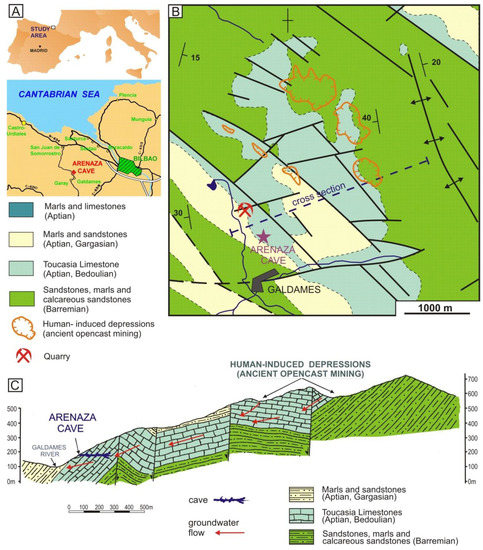
Figure 1.
Geographic and geological context of the study area. (A) Geographical location of Arenaza cave. (B) Geological map of the study area. (C) Geological cross section.
Arenaza Cave’s host rock is composed of metric to decimetric-thick beds of dark grey limestones (Urgonian limestone with Toucasia [22]) with terrigenous intercalations at the edges of the lithosomes (nodular, sandy limestones) (Figure 1C). These limestones show a massive, brecciated and amygdaloidal appearance with abundant calcite-filled cracks, pyrite moulds and poorly developed stylolite structures [2,22].
Cretaceous limestones in this area contain important iron ore deposits [22], which have been mined by subsurface and surface-mining methods since the beginning of 20th century [2,23,24,25,26]. The karstic system is highly altered because of the intense quarrying and mining activity in the area: modifications of the karstic drainage pattern and endo and exokarstic features, enlargement of the host-rock fissure network, modification of air circulation. Likewise, the environmental changes have led to the deterioration in the conservation conditions of the paintings [2].
Upper Palaeolithic rock art representations were discovered in 1973 [25,26,27]. Most of the parietal artistic representations are located in the chamber named “Paintings Sanctuary” or “Deer Room”, at 128 m from the entrance. The paintings (deer, bovid, and other figures) were made directly on the host rock or on thin speleothem deposits (Figure 2). Due to its archaeological values, Arenaza Cave was declared a Qualified Cultural Property (thus receives maximum protection) by the effects of the first additional disposition of the Law 7/90 of Basque Cultural Heritage [28,29] and different levels of protection areas were established (Figure 3A): area of protection of the archaeological site and Paintings Sanctuary (zone 1), area of general protection of the karst (zone 2), and area of general protection with tolerance of extractive activities (zone 3).
3. Materials and Methods
To assess the deterioration phenomena, detailed and comprehensive in situ visual analyses were performed before the sampling campaigns. The ICOMOS ICS glossary [30] was used for weathering form terminology. A total of 14 samples were taken in order to carry out a petrological, mineralogical, and geochemical characterization of the alteration processes that affect the site. These samples correspond both to fresh rock and to altered rock (flakes, patinas, deposits etc.). Analytical procedures were performed at the Geochemical and Geoenvironmental Monitoring Laboratory (MNCN-CSIC, Madrid, Spain). Samples were studied by using binocular loupe and petrographic microscope. X-ray diffraction was used to determine mineral composition in powdered samples and insoluble residues using quartz as an internal standard. The analyses were performed by using a PHILIPS PW-1710 XR-diffractometer operating at 40 kV and 30 mA, under monochromatic CuK radiation. The geochemical composition of the host rock and speleothems were determined using standard procedures with an X-ray fluorescence spectrometer (PHILIPS 1410/20 XRF spectrometer, (Amsterdam, The Netherlands).
4. Results
4.1. Influence of Mining Activity in the Karstic System
In Arenaza Cave, two different stages of anthropic activities have been identified that have irreversibly modified the natural karst characteristics:
- 1st Stage. Prior to the discovery of the paintings and related to mining prospecting work carried out in the first half of the 20th century, new galleries were opened and the morphological characteristics of other natural galleries were modified. Explosives were used for the opening of prospecting galleries from karstic conduits. Several alterations that modify the circulation of infiltration water are derived from these mining activities: (i) changes in the geomorphology of the cave, and (ii) fissuring of host limestone and/or joints and diaclases.
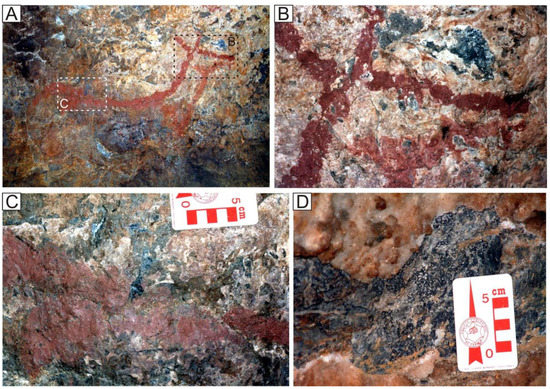
Figure 2.
Prehistoric cave paintings found on the walls of Arenaza cave. (A) General view of Red Deer in the Paintings Sanctuary. (B,C) Detail of the head and the back of the deer painting showing deterioration features (flakes, loss of pigments). (D) Detail of painting substrates (host limestone, calcite crust).
- 2nd Stage. Alterations subsequent to the discovery of the paintings, also related to mining activities in which explosives are used, due to the exploitation of aggregate quarries since the 1980s. Nowadays an active quarry for limestone aggregate extraction is located approximately 250–300 m from the Arenaza Cave. These limestones are the same that constitute the cave host rock. The effects produced by these activities are: (i) modifications in the karst morphology—the main karst collectors are now located in old natural depressions (dolines), which are remoulded by mining activities, and in artificial depressions (quarries), (ii) modification in both rate and direction of endokarstic water flow, even with openings of galleries to the outside and partial occlusion of others due to landslides, and (iii) the enlargement of host rock fissure network in the walls and floor of the cave by vibrations produced by blasting-induced vibrations.
In order to quantify the influence of the blasting-induced vibrations on caves housing prehistoric art, several technical studies have been carried out since the 1990s to determine the type of vibrations produced by the mining activity [23,31,32]. For the study of blasting-induced vibrations and transmitted by the ground, and due to the fact that there were no international regulations, the Spanish standard UNE 22-381-93 [33] on the control of vibrations made by blasting were used. This standard classifies three groups of structures with different degrees of application of the standard. Arenaza Cave belongs to Group III: structures of archaeological, architectural or historical value that present a special sensitivity to vibrations by themselves or by elements that they may contain. Based on the data from the controlled blasting carried out by the company EPM (Mining Studies and Projects) and the Applied Geophysics Service (Polytechnic University of Catalonia), it has been observed that the vibration frequency at the cave entrance is typically greater than 20 Hz and a model of the distribution of the vibration velocity has been produced (Figure 3). Likewise, from these data, the immediate maximum charge of explosives recommended for local use has been calculated that would not exceed the recommended vibration in the cave. Taking into account the explosive charges used in the quarry, we have calculated that the cave is affected by vibrations in a range from 0.4 mm/s to 0.6 mm/s (Figure 3B), a range inside the legal normative but higher than that expected from natural processes. Recently, the regional authorities responsible for the protection of the cave have established new operating standards for the company that operates the quarry near the cave, indicating that the vibration levels in the Paintings Sanctuary must be less than 0.5 mm/s [34]. Figure 3C shows the maximum value of explosive charges as a function of the distance to the cave that would have to be used to maintain a vibration speed of less than 0.5 mm/s.
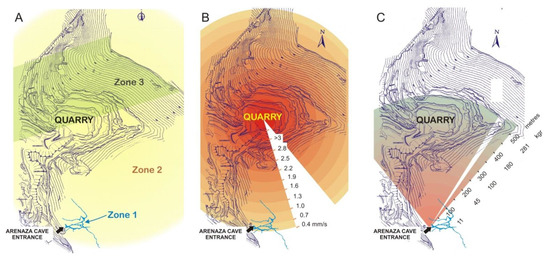
Figure 3.
Influence of nearby mining activity in the Arenaza cave area. (A) Levels of protection areas defined in the Arenaza Cave archaeological site. (B) Map of isolines showing the vibration velocity produced by controlled explosions from the quarry area near the cave. (C) Map of isolines that indicate the maximum calculated admissible explosive charges so that the vibrations in the “Paintings Sanctuary” are less than 0.5 mm/s.
4.2. Alteration Processes in the Cave Paintings
The alteration processes that affect cave paintings are related either to the alteration of the pigments, or to the alteration of the support on which these paintings have been made. In the Paintings Sanctuary, based on their composition, texture, degree of alteration, and chronology, two types of parietal surfaces on which the paintings were made can be distinguished: host rock and speleothems.
The petrographic study shows that host limestone are micrites and biomicrites with scattered clayey areas with diffuse contours. In addition to fragments of mollusks and foraminifera, mostly recrystallized, and some isolated quartz grains, these limestones contains moulds of small, highly-altered pyrite crystals (0.1–0.5 mm), mainly composed of clay minerals and iron oxides. Chemical and mineralogical analyses (Table 1) show these limestones are mainly composed of calcite (90–95%), with iron oxides (5–10%) and minor proportions of illite, pyrite and gypsum.
In direct relation to the paintings, two types or generations of speleothems can be recognized:
- A first phase of speleothems, on which the paintings are directly placed, made up of 1–3 mm-thick stalagmitic crusts that are mainly composed of calcite (92–96%) with low gypsum content (2–6%) (Figure 4A,B). They are formed by palisade calcite crystals that present dissolution textures on their surface. Locally, they show more complex textures with botryoidal aggregates that are rich in impurities (clays).
- A second phase of speleothems, located between the host rock and the first phase of speleothems (Figure 4C,D), mainly consisting of gypsum (95–97%) and smaller amounts of calcite and aragonite (<3%).

Table 1.
Average chemical composition (XRF analysis) of the different materials associated with cave paintings. (WL: weight loss).
Table 1.
Average chemical composition (XRF analysis) of the different materials associated with cave paintings. (WL: weight loss).
| Content (%) | Host Rock (Limestone) | 1st Phase Speleothem | 2nd Phase Speleothem (Fissure Infill) | 2nd Phase Speleothem (Surface Aggregate) |
|---|---|---|---|---|
| SiO2 | 4.40 | 0.31 | 0.27 | 4.40 |
| Al2O3 | 1.40 | 0.10 | 0.08 | 0.42 |
| Fe2O3 + FeO | 0.69 | 0.03 | 0.03 | 0.16 |
| MgO | 0.75 | 1.74 | 1.51 | 2.65 |
| CaO | 51.91 | 58.23 | 57.86 | 52.12 |
| K2O | 0.38 | 0.02 | 0.02 | 0.08 |
| TiO2 | 0.06 | 0.01 | 0.01 | 0.01 |
| P2O3 | 0.02 | 0.09 | 0.07 | 0.03 |
| WL | 40.10 | 39.45 | 40.15 | 39.40 |
| Total | 99.91 | 99.99 | 99.98 | 99.04 |
| Calcite | 95 | 94 | 4 | 4 |
| Aragonite | <2 | <3 | - | 2 |
| Dolomite | <3 | - | - | - |
| Quartz | <5 | - | - | - |
| Clays | <5 | <3 | <5 | <5 |
| Gypsum | - | 3 | 96 | 95 |
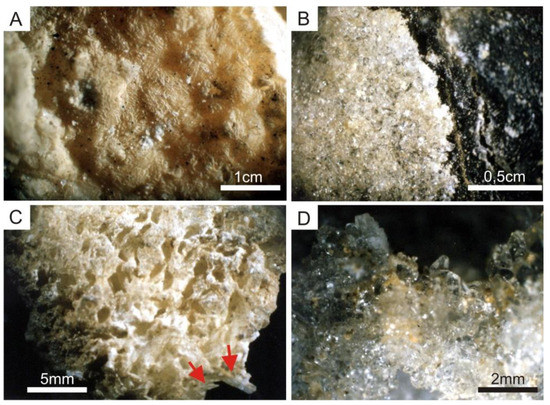
Figure 4.
Speleothems related to cave paintings. (A) Surface view of calcite speleothem (1st phase speleothems). (B) Calcite speleothem lining partially filled fissure. (C) Gypsum crust (2nd phase speleothems) with euhedral tabular crystals (highlighted by the arrows). (D) Gypsum aggregate formed by subhedral crystals.
Three main alteration processes affecting to host rock and paintings have been recognized:
- Loss of material (pigments) (Figure 2), due to leaching as result of surface (laminar) water circulation and/or natural condensation.
- Development of gypsum botryoidal concretions, which pick up and cause bulges in the paintings (Figure 4C,D); this process is poor-developed and seems to be modern.
- Contour scaling: Detachment of rock flakes that host cave paintings (Figure 5). There are two phases or stages in the detachment of scales or flakes: a poor-developed pre-painting phase and a recent post-painting phase that implies an important and irreversible degradation of the rock art. The size of the plates or flakes is centimetric, with thicknesses generally around 5 mm and less than 8 mm. Granular disintegration is commonly observed on the detachment surface of the flakes (Figure 5C). Growth of crystalline crusts related to both phases of the detachment processes can be observed.
The detachment surfaces are locally covered by fine, white microcrystalline deposits (Figure 5D). These precipitates are even more abundant in cracks and fractures. These crystalline deposit also appear on the inner face of the detached flakes. They are mainly gypsum in composition, with small proportions of calcite (1–2%) and aragonite (<1%). The low Si, Al, Mg and K contents correspond to clay inclusions. They present various types of textures: (i) aggregates composed of euhedral gypsum crystals up to 3 mm thick, prismatic in shape (the largest) and arranged perpendicular to the surface, (ii) botryoidal aggregates with fibrous-radial textures, and (iii) microcrystalline aggregates with a powdery appearance. The crystalline crusts that host the paintings belonging to the first detachment phase are linked with the first speleothems phase. By contrast, the crystalline crusts belonging to the recent active detachment phase is related to the second speleothems phase.
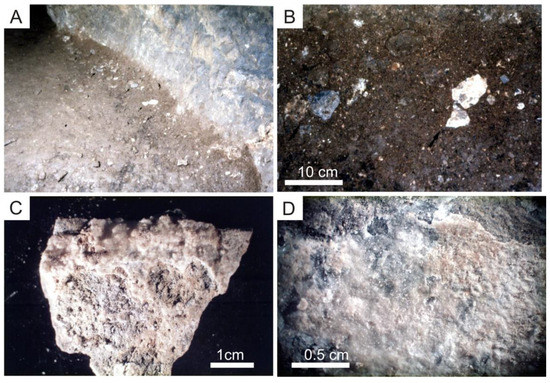
Figure 5.
Alteration processes affecting to cave paintings. (A) General view of the floor of the sanctuary where abundant plates (flakes) detached from the wall can be seen. (B) Detail of the fallen flakes. (C) View of the back of a detached flake showing the alteration (disaggregation) of the host rock. (D) View of the back of a detached flake where a fine speleothem crust is observed.
5. Discussion
Compositional differences between speleothem phases must be due to a change in the geochemical characteristics of karst water, which would probably be related to the modification of karst drainage by mining prospection labours. In the same way, the strong vibrations generated by the explosions in the nearby quarry expand the original fissure network in the host rock. Both fissure enlargement and crystallization pressure related to the growth of gypsum crusts are responsible for the recent reactivation and increase of the deterioration processes in the cave. The reactivation of water circulation through the fissures provoked their partial filling with calcite cement and the definitive dissolution of the gypsum present in the host rock and in the crystalline crusts. As a consequence, the water that circulates on the rock surface shows a composition enriched in sulphates comparing with the original that formed the first phase speleothems. The processes of recent deterioration of the cave paintings can be arranged in the following phases (Figure 6):
- I. Pre-mining phase. The paintings made on the different surfaces (host limestone and speleothems) suffer natural deterioration processes.
- II. Initial phase of mining activity. Mining labors lead to the enlargement of the initial host rock fissure network and an increase of the water flow rate on cave walls. This water flow favours leaching processes on cave paintings, selective dissolution of the gypsum fraction of the first phase speleothems, as well as further calcite cementation.
- III–IV. Active mining phase. Due to changes in the flow and the consequent modification of the hydrochemistry of the karst waters, the precipitation of crystalline gypsum aggregates occurs both in fissures and on the wall surfaces (second phase speleothems). Flake detachment is caused by crystallization pressure due to gypsum growth and by the vibration phenomena related to explosions in the nearby quarry.
Natural and anthropic activities may affect cave conservation. In the case of human activities (mining, farming, etc.), the delineation of protection areas is required to restrict and even forbid such activities when necessary [4,6,35]. Most karst protection policies involve restricting development around a karst feature by establishing a fixed radius or delineated area around the feature [5,36,37]. The Spanish–French meeting on Rock Art Conservation held in Colombres (Asturias) in June 1991 [19] established criteria for delimiting the “protected area” to preserve rock art caves and their surroundings. According to these recommendations and their subsequent reviews [5,23,37,38], several levels of protection can be defined. The “total protected area” and the “catchment and karst drainage area” are defined as the area occupied by the cave and its related exo- and endo-karst that can be affected by infiltration and hypogeal water circulation (the area that covers the infiltration waters that may potentially reach the cave). For this reason, no activity that may affect natural conditions should be permitted within these areas, including any activity that implies rock extraction or vibrations [38]. The blasting-induced vibrations generated in the area surrounding the cave will be transmitted directly to the cave, over the same geological strata that constitute the cave host rock, and at such short distances that they will not be attenuated. These strata, with very hard lithologies, are especially effective in transmitting vibrations over long distances.
6. Conclusions
Many different processes related to economic development can negatively impact rock art sites with different degrees of damage. Mining and quarrying activities are examples of the anthropogenic processes that can accelerate the degradation or even cause the destruction of rock art in cave environments. In the case of Arenaza Cave, the actions that involve nearby and recent mining activity (opencast quarries, underground mining) have caused serious deterioration of the Palaeolithic rock art by modifying the karstic geomorphology and hydrology.
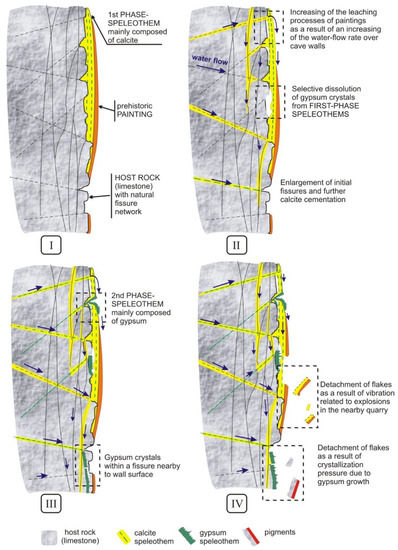
Figure 6.
Phases of recent deterioration affecting the cave paintings in Arenaza Cave (see text).
We have recognized three principal types of alteration processes affecting to host rock and paintings: (i) a natural process consisting in the disappearance of paintings by means of the direct action of flowing and/or condensing water, (ii) the development of gypsum concretions which pick up and cause bulges in the paintings (this process is poor-developed and seems to be modern), and (iii) the detachment of rock-flakes or scales which contain paintings. There are two phases of contour scaling, a poor-developed pre-painting phase and a recent post-painting phase, which lead to an important and irreversible degradation of the cave paintings. We have observed the growth of a crystalline crust related to both phases of the detachment phenomena.
Both the crystalline crusts belonging to the first detachment phase and the stalagmitic crusts that host the paintings are mainly constituted by calcite with low content of gypsum (<6%). By contrast, the crystalline crusts belonging to the recent active detachment phase mainly consist of gypsum with a minor percentage of calcite and aragonite (<3%). These compositional differences are due to changes in the flow and geochemical characteristics of karstic water, which is probably related to the modification of karstic drainage by mining prospection and exploitation labours. In the same way, the strong vibrations generated by the explosions in the nearby quarry expand the original fissure network of host rock. Both the enlargement of host rock fissure network and the crystallisation pressure due to the growth of gypsum crusts are responsible for the recent reactivation and increase of the deterioration processes in the cave.
Author Contributions
Conceptualization, J.C.C. and S.S.-M.; methodology J.C.C. and S.S.-M.; investigation, J.C.C., M.C.M.-C. and S.S.-M.; writing—original draft preparation, J.C.C., M.C.M.-C. and S.S.-M.; writing—review and editing, J.C.C. All authors have read and agreed to the published version of the manuscript.
Funding
This research was supported by the Spanish Ministry of Science and Innovation through project PID2019-110603RB-I00 project, MCIN/AEI/FEDER, UE/10.13039/501100011033.
Institutional Review Board Statement
Not applicable.
Informed Consent Statement
Not applicable.
Data Availability Statement
Not applicable.
Acknowledgments
In memoriam to our dear Manolo Hoyos (1944–1999), a master geologist and pioneering geoarchaeologist. The authors wish to acknowledge the professional support of the CSIC Interdisciplinary Thematic Platform Open Heritage: Research and Society (PTI-PAIS).
Conflicts of Interest
The authors declare no conflict of interest.
References
- Cigna, A.A. Environmental management of tourist caves. Environ. Geol. 1993, 21, 173–180. [Google Scholar] [CrossRef]
- Hoyos, M. Procesos de alteración de soporte y pintura en diferentes cuevas con arte rupestre del norte de España: Santimamiñe, Arenaza, Altamira y Llonín. Mesa Redonda Hispano-francesa. Colombres-Asturias: 3 a 6 de junio de 1991. In La Protección y Conservación del Arte Rupestre Paleolítico; Fortea, J., Ed.; Consejería de Educación y Cultura: Oviedo, Spain, 1993; pp. 51–74. [Google Scholar]
- Hoyos, M.; Cañaveras, J.C.; Sánchez-Moral, S.; Sanz-Rubio, E.; Soler, V. Microclimatic characterization of a karstic cave: Human impact on microenvironmental parameters of a prehistoric rock art cave (Candamo Cave, northern Spain). Environ. Geol. 1998, 33, 231–242. [Google Scholar] [CrossRef]
- Cañaveras, J.C.; Sánchez-Moral, S.; Soler, V. Protección y conservación de cavidades kársticas con arte rupestre. In Documentos del XIII Simposio de la Enseñanza de la Geología; Alfaro, P., Andreu, J.M., Cañaveras, J.C., Yébenes, A., Eds.; Instituto de Ciencias de la Educación. Univ.: Alicante, Spain, 2004; pp. 54–60. [Google Scholar]
- Cañaveras, J.C.; Cuezva, S.; Sanz-Rubio, E.; Sánchez-Moral, S. Definition of protection areas in a prehistoric art cave (Tito Bustillo cave, N Spain). In Heritage, Weathering and Conservation; Fort, R., Alvárez Buergo, M., Gómez-Heras, M., Vázquez-Calvo, C., Eds.; Routledge: London, UK; Taylor & Francis Group: Oxfordshire, UK, 2006; pp. 813–817. [Google Scholar]
- Iriarte, E.; Sánchez, M.A.; Foyo, A.; Tomillo, C. Geological risk assessment for cultural heritage conservation in karstic caves. J. Cult. Herit. 2010, 11, 250–258. [Google Scholar] [CrossRef]
- van Beynen, P.; Brinkmann, R.; van Beynen, K. A sustainability index for karst environments. J. Cave Karst Stud. 2012, 74, 221–234. [Google Scholar] [CrossRef]
- Sánchez-Moral, S.; Cañaveras, J.C.; Sanz-Rubio, E.; Soler, V.; Van Grieken, R.; Gysels, K. Inorganic deterioration affecting Altamira Cave. Quantitative approach to wall corrosion (solution etching) processes induced by visitors. Sci. Total Environ. 1999, 243, 67–84. [Google Scholar] [CrossRef]
- Saiz-Jimenez, C.; Cuezva, S.; Jurado, V.; Fernández-Cortes, A.; Porca, E.; Benavente, D.; Cañaveras, J.C.; Sánchez-Moral, S. Paleolithic art in peril: Policy and science collide at altamira cave. Science 2011, 334, 42–43. [Google Scholar] [CrossRef]
- Lacanette, D.; Large, D.; Ferrier, C.; Aujoulat, N.; Bastian, F.; Denis, A.; Jurado, V.; Kervazo, B.; Konik, S.; Lastennet, R.; et al. A laboratory cave for the study of wall degradation in rock art caves: An implementation in the Vézère area. J. Arch. Sci. 2013, 40, 894–903. [Google Scholar] [CrossRef]
- Zerboni, A.; Villa, F.; Wu, Y.-L.; Solomon, T.; Trentini, A.; Rizzi, A.; Cappitelli, F.; Gallinaro, M. The Sustainability of Rock Art: Preservation and Research. Sustainability 2022, 14, 6305. [Google Scholar] [CrossRef]
- Gunn, J. The geomorphological impacts of limestone quarrying. Catena 1993, 15, 187–198. [Google Scholar]
- Gunn, J. (Ed.) Quarrying of limestones. In Encyclopedia of Cave and Karst Science; Routledge: London, UK, 2004; pp. 608–611. [Google Scholar]
- LaMoreaux, P.E.; Powell, W.J.; LeGrand, H.E. Environmental and legal aspects of karst areas. Environ. Geol. 1997, 29, 23–36. [Google Scholar] [CrossRef]
- Langer, W.H. Potential Environmental Impacts of Quarrying Stone in Karst. A Literature Review. U.S. Geological Survey Open-File Report 2001, OF-01-0484. Available online: http://geology.cr.usgs.gov/pub/ofrs/OFR-01-0484/ (accessed on 22 June 2022).
- Ford, D.; Williams, P. Karst Hydrogeology and Geomorphology; John Wiley & Sons: Hoboken, NJ, USA, 2007; 576p. [Google Scholar]
- Parise, M. The impacts of quarrying in the Apulian karst (Italy). In Advances in Research in Karst Media; Andreo, B., Carrasco, F., Durán, J.J., LaMoreaux, J.W., Eds.; Springer: Berlin, Germany, 2010; pp. 441–447. [Google Scholar]
- Álvarez, I.; Bodego, A.; Aranburu, A.; Arriolabengoa, M.; del Val, M.; Iriarte, E.; Abendaño, V.; Calvo, J.I.; Gárate, D.; Hermoso de Mendoza, A.; et al. Geological risk assessment for rock art protection in karstic caves (Alkerdi Caves, Navarre, Spain). J. Cult. Herit. 2018, 33, 170–180. [Google Scholar] [CrossRef]
- Fortea, J. (Ed.) La Protección y Conservación del Arte Rupestre Paleolítico; Mesa Redonda Hispano-Francesa (Colombres, 1991); Servicio de Publicaciones de la Consejería de Educación, Cultura, Deportes y Juventud del Principado de Asturias: Oviedo, Spain, 1993; 191p. [Google Scholar]
- Fortea, J.; Hoyos, M. La table ronde de Colombres et les études de protection et conservation en Asturies réalisées de 1992 à 1996. Bull. Soc. Préhist. Ariège-Pyrénées 1999, 54, 235–242. [Google Scholar]
- Serrano Diez-Canedo, A.; Fernández Alonso, O.; Eraso, A. Estudio hidroeológico de las calizas de Galdames. Jorn. Sobre Karst Eusk. 1986, I, 61–80. [Google Scholar]
- Instituto Geológico y Minero de España. Mapa Geológico de España, Bilbao 61 (25-1), Escala 1:50.000; Instituto Geológico y Minero de España: Madrid, Spain, 1975. [Google Scholar]
- Hoyos, M.; Sánchez-Moral, S.; Cañaveras, J.C.; Sanz Rubio, E. Informe Sobre la Delimitacion del Area de Protección Total de la CUEVA de Arenaza (Galdames, Vizcaya); Consejería de Educación y Cultura del Gobierno Vasco: Madrid, Spain, 1994; 12p. [Google Scholar]
- Gárate, D.; Jiménez, J.M.; Ortiz, J. El arte rupestre paleolítico de la cueva de Arenaza (Galdames, Bizkaia). Kobie (Paleoantropol.) 2000, 26, 5–64. [Google Scholar]
- Gárate, D. Nuevas investigaciones sobre el arte parietal paleolítico de la cueva de Arenaza (Galdames, Bizkaia). Munibe 2004, 56, 3–17. [Google Scholar]
- Gárate, D.; Laval, E.; Menu, M. Étude de la matière colorante de la grotte d’Arenaza (Galdames, Pays Basque, Espagne). L’anthropologie 2004, 108, 251–289. [Google Scholar] [CrossRef]
- Apellaniz, J.M. El Arte Prehistórico del País Vasco y sus Vecinos; Desclée de Brouwer: Bilbao, Spain, 1982; 232p. [Google Scholar]
- RESOLUCIÓN de 5 de octubre de 2010, del Viceconsejero de Cultura, Juventud y Deportes, por la que se impulsa la tramitación del expediente de adaptación a las prescripciones de la Ley 7/1990, de 3 de julio, de Patrimonio Cultural Vasco de la declaración de la Cueva de Arenaza I de Galdames (Bizkaia) como Bien Cultural Calificado con la categoría de Conjunto Monumental, y se establece una nueva delimitación, una nueva descripción y un nuevo régimen de protección. Basque Official Gazette 2010, 207, 5959. Available online: https://www.euskadi.eus/y22-bopv/es/bopv2/datos/2010/10/1004959a.pdf (accessed on 16 July 2022).
- DECRETO 111/2012, de 19 de junio, por el que se adapta a las prescripciones de la Ley 7/1990, de 3 de julio, del Patrimonio Cultural Vasco, el expediente de Bien Cultural Calificado, con la categoría de Conjunto Monumental, a favor de la Cueva de Arenaza I de Galdames (Bizkaia), y se establece una nueva delimitación, una nueva descripción y un nuevo régimen de protección. Basque Official Gazette 2012, 128, 3000. Available online: https://www.euskadi.eus/y22-bopv/es/bopv2/datos/2012/07/1203000a.pdf (accessed on 16 July 2022).
- ICOMOS-ICS. Illustrated Glossary on Stone Deterioration Pattern. 2008. Available online: http://international.icomos.org/publications/monuments_and_sites/15/pdf/Monuments_and_Sites_15_ISCS_Glossary_Stone.pdf (accessed on 12 July 2022).
- Sánchez-Moral, S.; Sanz-Rubio, E.; Soler, V. Análisis del estado de conservación de la roca soporte de las pinturas y registro y análisis de vibraciones de fondo en la Cueva de Urdiales. In Cueva Urdiales (Castro Urdiales, Cantabria); Montes, R., Muñoz, E., Morlote, J.M., Eds.; Ayuntamiento de Castro Urdiales: Cantabria, Spain, 2005; pp. 133–138. [Google Scholar]
- Abella, R.; Sánchez-Moral, S. Registro de Vibraciones en la Cueva de Cobrante (Voto, Cantabria): Análisis de la Influencia de Obras Específicas de Perforación Dentro de su Área de Protección Total; Informe inédito para la empresa REE y la Consejería de Cultura, Turismo y Deporte de Cantabria: Cantabria, Spain, 2007; 9p. [Google Scholar]
- Control of Vibrations Made by Blasting. UNE 22-381-93; Asociación Española de Normalización y Certificación: Madrid, Spain, 1993; 12p.
- RESOLUCIÓN de 18 de octubre de 2021, del Director de Calidad Ambiental y Economía Circular, por la que formula la declaración de impacto ambiental de la modificación del proyecto de explotación de la cantera Galdames II, ubicada en las concesiones de explotación de la Sección C) denominadas «Galdames II» n.º 12.793 y «Galdames II Ampliación» n.º 12.807, en el término municipal de Galdames (Bizkaia), promovido por Áridos y Canteras del Norte, S.A. Basque Official Gazette 2021, 227, 5828. Available online: https://www.euskadi.eus/y22-bopv/es/bopv2/datos/2021/11/2105828a.pdf (accessed on 18 July 2022).
- Cañaveras, J.C.; Sánchez-Moral, S. Impacto ambiental del hombre en las cuevas. In Karst and the Environment; Carrasco, F., Durán, J.J., Andreo, B., Eds.; Springer: Berlin/Heidelberg, Germany, 2010; pp. 499–504. [Google Scholar]
- Despain, J.; Fryer, S. Hurricane crawl cave: A GIS-based cave management plan analysis and review. J. Cave Karst Stud. 2002, 64, 71–76. [Google Scholar]
- Elez, J.; Cuezva, S.; Fernández-Cortes, A.; García-Antón, E.; Benavente, D.; Cañaveras, J.C.; Sánchez-Moral, S. A GIS-based methodology to quantitatively define an Adjacent Protected Area in a shallow karst cavity: The case of Altamira cave. J. Environ. Manage. 2013, 118, 122–134. [Google Scholar] [CrossRef] [PubMed]
- Sánchez, M.A.; Foyo, A.; Tomillo, C.; Iriarte, E. Geological risk assessment of the Altamira Cave: A proposed Natural Risk Index and Safety Factor for the protection of prehistoric Caves. Eng. Geol. 2007, 94, 180–182. [Google Scholar] [CrossRef]
Publisher’s Note: MDPI stays neutral with regard to jurisdictional claims in published maps and institutional affiliations. |
© 2022 by the authors. Licensee MDPI, Basel, Switzerland. This article is an open access article distributed under the terms and conditions of the Creative Commons Attribution (CC BY) license (https://creativecommons.org/licenses/by/4.0/).